Buenos Aires – No, it’s not a foreign word, it was just a day of “cultcha.” You know – art, music, etc. The day started out planned around an evening concert with friends in the San Martin (Centro) district. I did a quick internet search and discovered a modern art museum, the Centro Cultural Borges, was in the same neighborhood, so I headed there early in the afternoon. First off was the need for sustenance. As I arrived at the corner where the gallery was located, a young man was passing out flyers for a local sushi bar. I’ve been complaining about the lack of sushi, so I figured I’d give it a try. The place is called Seis50 (“650”), at, not surprisingly, San Martin 650.
Seis50 is a gleaming white, very trendy looking establishment. 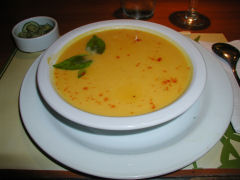 It was chockful of business types wolfing down sushi and pasta (hey, I didn’t write the menu). Although the website shows lovely photos of Japanese folk manning the place, all faces in sight; in the kitchen, behind the bar, or waiting tables; were non-Asian. Unlike typical U.S. sushi bars, sushi was being prepared semi-out of site, behind the sushi bar, but without a glass front. I asked the barman for the soup of the day, a request that took him a solid five minutes to find out just exactly what it was – not a waitron in the place seemed to know. Soon, however, I had a lovely bowl of Crema de calabaza (creamed pumpkin soup) that was seasoned perfectly with black pepper and basil.
It was chockful of business types wolfing down sushi and pasta (hey, I didn’t write the menu). Although the website shows lovely photos of Japanese folk manning the place, all faces in sight; in the kitchen, behind the bar, or waiting tables; were non-Asian. Unlike typical U.S. sushi bars, sushi was being prepared semi-out of site, behind the sushi bar, but without a glass front. I asked the barman for the soup of the day, a request that took him a solid five minutes to find out just exactly what it was – not a waitron in the place seemed to know. Soon, however, I had a lovely bowl of Crema de calabaza (creamed pumpkin soup) that was seasoned perfectly with black pepper and basil.
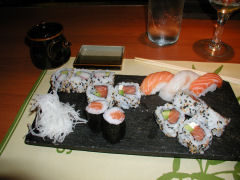 I ordered the Sushi surtido, or selection of sushi, figuring that maybe I’d manage something other than the list of various salmon rolls on the menu. I received a 14-piece, nicely plated on a piece of slate, selection of, well, salmon. Okay, only 10 of the 14 were salmon. The selection was – 2 pieces of salmon sushi, 2 pieces of plain salmon roll, 2 pieces of “New York roll” (salmon & avocado), 2 pieces of “Philadelphia roll” (salmon, avocado & cream cheese), 3 pieces of “California roll” (crab stick & avocado), and 1 piece of unidentified “pescado blanco” (white fish, I’d guess from looking at it that it was some type of sea bass). It was all fresh, and reasonably good. Unfortunately, true to porteño form, there was no spice – soy sauce was offered, neither pickled ginger nor wasabi were available; in fact, all I got were blank looks in response to my request; I’m fairly sure they had no idea what I was talking about.
I ordered the Sushi surtido, or selection of sushi, figuring that maybe I’d manage something other than the list of various salmon rolls on the menu. I received a 14-piece, nicely plated on a piece of slate, selection of, well, salmon. Okay, only 10 of the 14 were salmon. The selection was – 2 pieces of salmon sushi, 2 pieces of plain salmon roll, 2 pieces of “New York roll” (salmon & avocado), 2 pieces of “Philadelphia roll” (salmon, avocado & cream cheese), 3 pieces of “California roll” (crab stick & avocado), and 1 piece of unidentified “pescado blanco” (white fish, I’d guess from looking at it that it was some type of sea bass). It was all fresh, and reasonably good. Unfortunately, true to porteño form, there was no spice – soy sauce was offered, neither pickled ginger nor wasabi were available; in fact, all I got were blank looks in response to my request; I’m fairly sure they had no idea what I was talking about.
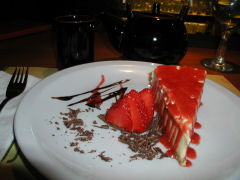 A full selection of desserts was offered, fairly “north american” in style, and I opted to see what they’d done for chese cake. Honestly, not far off of a pretty typical New York style cheesecake. I tend to prefer the denser, European style baked cheesecakes, this was a bit lighter and creamier. It was topped with a strawberry puree and accompanied by fresh strawberries and shaved semi-sweet chocolate. All in all, pretty good. A pot of freshly steeped green “sen-cha” tea finished off my meal. Grand total: 44 pesos, or roughly $15 (not surprisingly expensive given that salmon is one of the priciest fish here). This salmon only thing is something I have to get a straight answer to (none was forthcoming from the sushi-man) – it’s far and away pricier than any other fish available here in fish markets, as far as I know, it’s imported from North America. Why local fish, i.e., those fished from the patagonian waters an hour or two south of here, are not served, I haven’t found out. (A friend suggested that it’s most likely that there’s no refrigerated transport system from the coast, but that seems dubious; a block of ice for a one hour trip would suffice.)
A full selection of desserts was offered, fairly “north american” in style, and I opted to see what they’d done for chese cake. Honestly, not far off of a pretty typical New York style cheesecake. I tend to prefer the denser, European style baked cheesecakes, this was a bit lighter and creamier. It was topped with a strawberry puree and accompanied by fresh strawberries and shaved semi-sweet chocolate. All in all, pretty good. A pot of freshly steeped green “sen-cha” tea finished off my meal. Grand total: 44 pesos, or roughly $15 (not surprisingly expensive given that salmon is one of the priciest fish here). This salmon only thing is something I have to get a straight answer to (none was forthcoming from the sushi-man) – it’s far and away pricier than any other fish available here in fish markets, as far as I know, it’s imported from North America. Why local fish, i.e., those fished from the patagonian waters an hour or two south of here, are not served, I haven’t found out. (A friend suggested that it’s most likely that there’s no refrigerated transport system from the coast, but that seems dubious; a block of ice for a one hour trip would suffice.)
[Note: This restaurant has closed.]
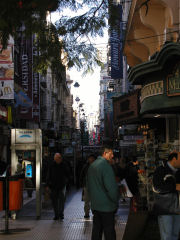 After lunch it was down the block to the Centro Cultural Borges, at the corner of San Martin and Viamonte. This is a multi-level gallery of contemporary art that is located in the core of the Galeria Pacifico. Now, a tangent here, there is a pedestrian mall that is pretty much the heart of tourist shopping here. It runs the length of Calle Florida, a pedestrian only street that begins at its eastern end at Plaza San Martin and extends west by roughly a dozen blocks. Originally, the anchor store at the eastern end was the now abandoned seven-story hulk of the department store Harrod’s.
After lunch it was down the block to the Centro Cultural Borges, at the corner of San Martin and Viamonte. This is a multi-level gallery of contemporary art that is located in the core of the Galeria Pacifico. Now, a tangent here, there is a pedestrian mall that is pretty much the heart of tourist shopping here. It runs the length of Calle Florida, a pedestrian only street that begins at its eastern end at Plaza San Martin and extends west by roughly a dozen blocks. Originally, the anchor store at the eastern end was the now abandoned seven-story hulk of the department store Harrod’s. 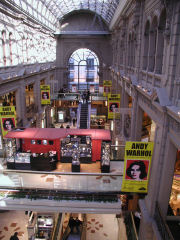 Each block, in addition to the various open to the walkway stores, has a “galeria,” or enclosed shopping mall, ranging from small to grand, and generally varying in theme. Galeria Pacifico is probably the largest, in the second block, and is focused around higher end clothing.
Each block, in addition to the various open to the walkway stores, has a “galeria,” or enclosed shopping mall, ranging from small to grand, and generally varying in theme. Galeria Pacifico is probably the largest, in the second block, and is focused around higher end clothing.
The gallery is one of those places that I wish I had had someone along who is conversant in the topic of contemporary art. Most of it is open to the public for free. There are two galleries that are by admission only, and have separate entrance fees. I’d set out specifically wanting to see the Salvador Dali exhibit (the other is an Andy Warhol exhibit) that is here for August. I was expecting something sort of small and not particularly extensive, and I was pleasantly surprised to find that it was a quite large salon of pictures, jewelry, and medallions that he created over the years. The focus of the exhibit was the anniversary of the publication of his illustrated Don Quijote, However much of the space was devoted to his “Codigo,” essentially a tie-in with Leonardo DaVinci brought about through the writings of Dan Brown in The DaVinci Code (quite good, by the way, despite the hype, and his “precursor” book, Angels & Demons is even better), Walt Disney’s Destino, the knights of the Round Table, and the Last Supper. Interestingly, Dali’s painting of the Last Supper has Jesus as a very nordic looking type – actually, he reminded me of Orlando Bloom’s elven character Legolas, in The Lord of the Rings (see below, go ahead, tell me I’m nuts…). The rest of the exhibit included a part of Dali’s Tarot deck, and another nine different series of work (El Quijote illustrations, Casanova, Anamorfosis, Time, and others).
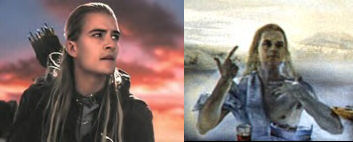
It was a fascinating look at one of the 20th centuries pre-eminent surrealists. What was almost more fascinating were the public galleries. These consisted of various other, and I gathered latin american, artists, all working in surrealistic or similar modes. Marta Minujín’s tile on glass figures were brightly colored and kind of fun. 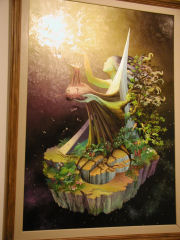 There was a rather odd display of Vespas, the Italian motorcycles, that included not only a dozen or so of the machines themselves, but also a wide range of advertising posters. I think my favorite gallery was that of two artists, Ileana Cerato and Julio Alessandroni, entitled El grito de la Tierra (“Shout of the Earth”), which ranged from pen and ink drawings to large multi-colored murals like this one entitled Galaxia del Vida, or Galaxy of Life.
There was a rather odd display of Vespas, the Italian motorcycles, that included not only a dozen or so of the machines themselves, but also a wide range of advertising posters. I think my favorite gallery was that of two artists, Ileana Cerato and Julio Alessandroni, entitled El grito de la Tierra (“Shout of the Earth”), which ranged from pen and ink drawings to large multi-colored murals like this one entitled Galaxia del Vida, or Galaxy of Life.
Other artists that had their own gallery spaces:
Gabriel López Sartiso’s Encadenamiento del color (“Color chain”) – this painting merely entitled “S/T”
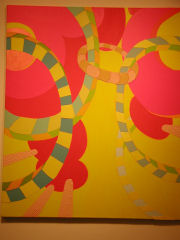
Francisco Capillo’s Las homomensuras (“Equal measures”) – painting entitled “Él y nosotros,” or “Him and others”
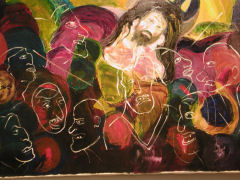
Adriana Fiterman’s Corte 2003-5 – painting entitled “¿Ineficientes?” or “ineffectives”
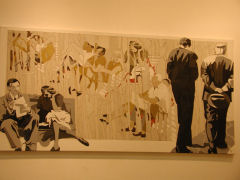
Ricardo Pascale’s new sculpture exhibit – a collection of inlaid wood wheels and plaques
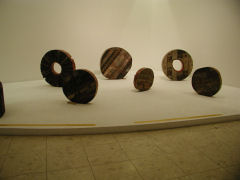
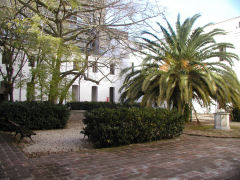 The afternoon ended with a brief visit to the neighboring Santa Catalina Monasterio, a medium sized church with attached monastery. The church itself wasn’t all that interesting, with fairly typical statuary. The one fascinating note for me, but then I know very little of catholic saints, was the alcove for St. Martin, where he is displayed as a young black man. [Edit: Okay, did a little websearch. Who knew there were so many St. Martins? This one was, and I do remember it on the inscription, St. Martin de Porres, who indeed was a half spanish, half black member of the Dominican order.] The cloisters had a beautiful and quite tranquil courtyard that during warm weather appears to have a cafe. There is also a religious library, that is apparently accessible on request, that contains not only historical religious books, but an art gallery.
The afternoon ended with a brief visit to the neighboring Santa Catalina Monasterio, a medium sized church with attached monastery. The church itself wasn’t all that interesting, with fairly typical statuary. The one fascinating note for me, but then I know very little of catholic saints, was the alcove for St. Martin, where he is displayed as a young black man. [Edit: Okay, did a little websearch. Who knew there were so many St. Martins? This one was, and I do remember it on the inscription, St. Martin de Porres, who indeed was a half spanish, half black member of the Dominican order.] The cloisters had a beautiful and quite tranquil courtyard that during warm weather appears to have a cafe. There is also a religious library, that is apparently accessible on request, that contains not only historical religious books, but an art gallery.
More on this evening’s festivities in the next post…
[…] in Buenos Aires have ended up with lackluster response, and fairly quickly went out of business (Söder and Bread + Butter). But those were a few years ago, and someone decided it was time to give it […]